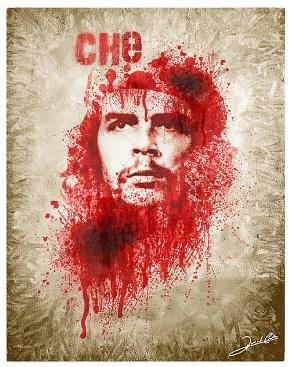The blood on Che’s shirt – by Caroline Carlson
 The
first time I saw a Che Guevara T-shirt was in the eleventh grade. I
didn’t know who Che Guevara was, but was instantly able to recognize him
whenever I saw kids walk through the halls wearing T-shirts and
carrying backpacks or lighters with his face on them. The image – a
young Argentinian man with long hair and a beret – became almost
universally known and sparked a global marketing campaign.
The
first time I saw a Che Guevara T-shirt was in the eleventh grade. I
didn’t know who Che Guevara was, but was instantly able to recognize him
whenever I saw kids walk through the halls wearing T-shirts and
carrying backpacks or lighters with his face on them. The image – a
young Argentinian man with long hair and a beret – became almost
universally known and sparked a global marketing campaign.Unbeknownst to many young people, Che Guevara was an international terrorist who aided Fidel Castro in the overthrow of the Cuban government in the late 1950s. After leading a two-year guerrilla campaign against Cuban dictator Fulgencio Batista, he led firing squads against alleged war criminals, created a “labor camp” system in Cuba that imprisoned and killed Jehovah’s Witnesses and homosexuals and oversaw the deaths of more than 1,000 people.
Tomorrow marks the 45th anniversary of Che’s death.
It makes no sense whatsoever for your average, independent-minded college student to support “equality” or wear Human Rights Campaign t-shirts while thinking the Hispanic version of Hitler is “really cool.” What some people don’t seem to realize is when you
Some who have woken up to the realities of Guevara’s militant history have labeled this day as “No More Che Day,” a day to educate ourselves on the reality of Che and shine light on how vulnerable youth are to cultural trends. Young people’s willingness to jump on the bandwagon seems to be ever increasing, whether we are talking about slogans, images or entire political movements. It’s almost as if we consider the “coolness” of taking part in a political activity before we actually do our homework on the issues.
We can’t be brainwashed by marketing campaigns that treat sadistic killers as idols. Although some may argue the Che t-
Some say that the Cult of Che has died down in relation to years past. Even if this is true, real change against collective thinking starts with enlightenment. Being armed with knowledge and research is the strongest way to fight an ignorant trend, rather than waiting to let it dwindle and let an even more ignorant trend emerge upon us again.
* Caroline Carlson is a sophomore government and politics and marketing major at The University of Maryland.
No comments:
Post a Comment